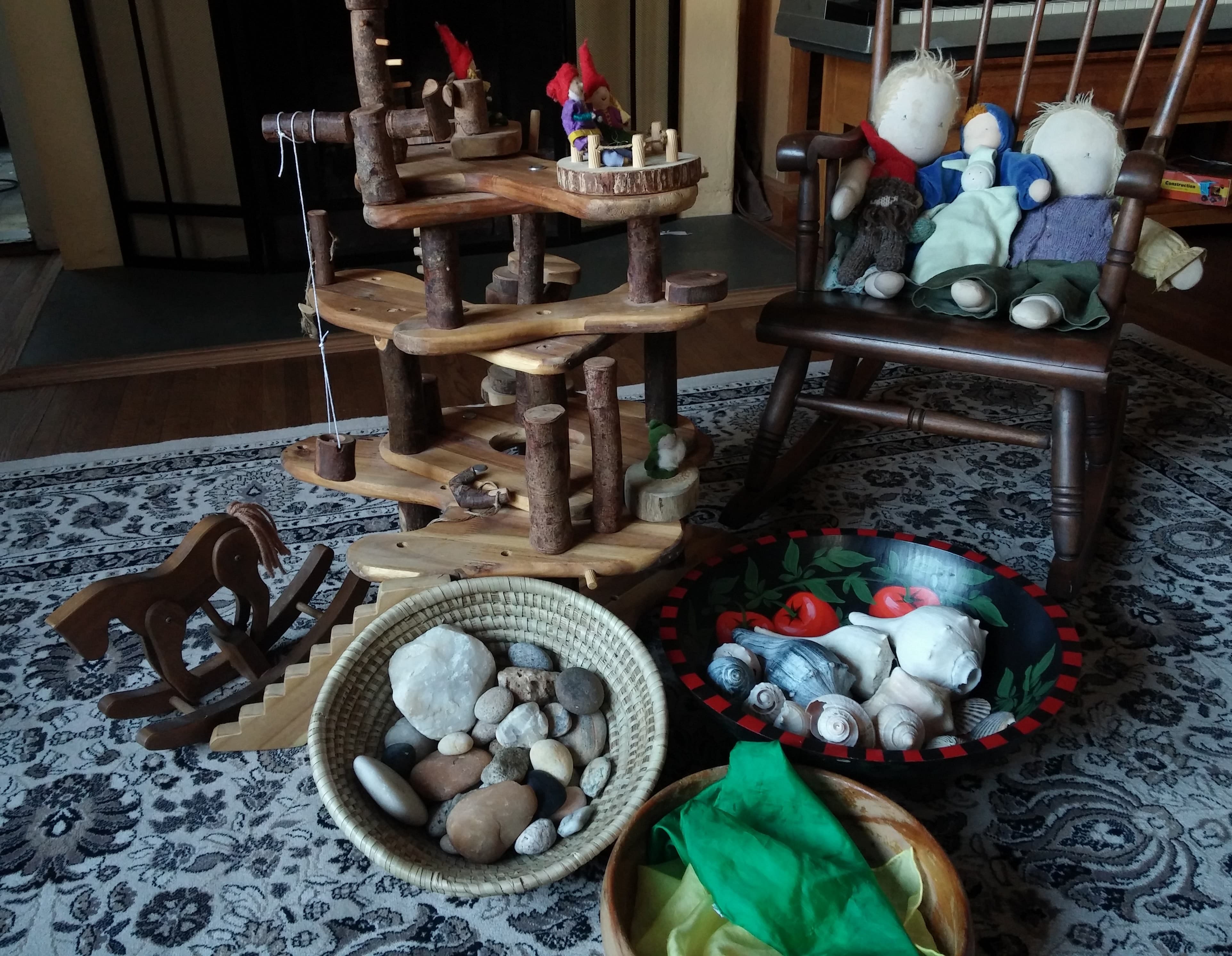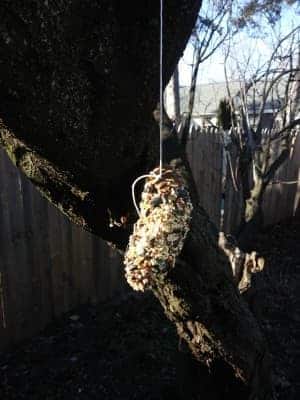5 Tips for Screen-Free Winter Play
As a parent, grandmother and educator, I have spent a lot of time around young children. I have observed that they are blessed with active imaginations. Active, creative play helps children learn about the world. We can support creative play by offering children toys and materials from nature and by making opportunities for them to spend time in nature—yes, even in the wintertime!
We tend to spend more time indoors and on our devices this time of year. In the fall, I shared five activities to help children avoid screen time. Some of those activities can be done any time of year, and depending on where you live, you might also be able to jump in puddles (activity #2). But winter does present unique challenges.
Here are my five tips for screen-free winter fun:
1. Bundle up and get outside (unless it’s in the single digits and windy)
If you dress warm and there isn’t too much wind, cold temperatures are refreshing and healthy for all of us, especially children. I’ve noticed that children tend to sleep better and get sick less when they spend time outside everyday. As a person who doesn’t like the cold, I know that getting yourself and your kids outside in winter isn’t easy. But it’s worth it! Another bonus of outdoor play is that you don’t have to lead activities–kids will find their own ways to get engaged and have fun.
Make sure your children have adequate winter clothing, right down to their mittens and socks. If your child is in day care or school, advocate for time outside everyday. Teachers and caregivers often say that they can’t take kids outside because parents don’t dress them warm enough. As a former teacher, I know it’s also true that we adults often don’t want to go outside ourselves! Let’s all step up a bit so kids can spend more time outside this winter.
2. Gather simple toys from nature

The simplest toys are great because they require the child to use their imagination and they don’t thwart children’s innate creativity. A toy that can be used for different purposes requires more from the player than a toy that has only one purpose. For example, with a basket of stones, a kid can build a wall or a road; make stone soup; count “money”; make dishes for a playhouse party; etc. A toy spaceship, on the other hand, is just a spaceship.
Many toys from nature have the added benefit of being naturally non-toxic. Toys from nature are also durable and interesting in their shape, form and color. Go out with your kids and gather things like stones, shells, pinecones, and small branches.
When you buy toys, look for ones made from wood, wool, and cloth. Nova Natural Toys & Crafts is a great source for Waldorf-inspired toys. You can find the gnome treehouse and Playsilks pictured here on Amazon.
3. Care for birds and squirrels
My grandchildren love sitting by the window and watching animals. Birds and squirrels are the wildest creatures that many children get to see outside the zoo. Caring for them is a simple way to help kids feel a connection to nature and a responsibility for its well-being.
Here are some tips, inspired by Carol Petrash’s Earthways.
- Set up a feeding station in a place that’s within view of your window. If you’re not on the ground floor, consider using an external windowsill. (Maia has this window bird feeder attached to the window of her Brooklyn apartment.)
- Birds like a protected area, so a bush or tree is a great place to hang a bird feeder. Larger container plantings will work too. You can buy a bird feeder or make one with your kids (see instructions at the end of this post).
- For squirrels, place nuts on the ground or on a low stump or rock. Squirrels also like corn cobs, apple cores, carrot tops and pumpkin seeds.
- Offer a birdbath. You can use a traditional birdbath or a large shallow pan, dish, or plant saucer. The birdbath should be emptied and cleaned weekly (scrub it with a brush and water–don’t use soap).
If the birds and squirrels don’t come right away, be patient! They’ll soon find your offerings. Maia’s boys had nearly given up on seeing birds and now they see dozens daily.
Related Post: 5 Fresh Strategies for Screen-Free Play
4. Sit and watch
Ernest Thompson Seton, a naturalist and co-founder of the Boy Scouts of America, learned the secrets of Mother Nature by sitting quietly and tuning into his natural surroundings. His work inspired this “sit and watch” activity, also known as the Seton Watch. This activity involves sitting still for five to ten minutes, so it’s best for school-aged kids. Here’s how to do it (from Joanne Dennee’s Exploring the Forest With Grandfather Tree.):
- Find a comfortable place to sit outside.
- Be quiet and tune into your surroundings with all of your senses. Try to feel what’s going on around you.
- After five to ten minutes, Mother Nature may reveal some almost invisible, magical details of winter, things you might otherwise miss. Watch and listen for insects or animals; look at colors and silhouettes of the winter landscape; look for snow crystals or frost formations shimmering in the sunshine; listen to and feel the wind; listen to the questions that your quiet self wants to ask.
- When you come inside, draw a picture of yourself in the winter landscape. You can also read aloud stories from Seton’s Wild Animals I Have Known.
5. Enjoy finger games, circle games, and singing
Children naturally love music, rhyming, and games. These activities are great ways to spend screen-free time indoors:
- Finger games like “The Itsy Bitsy Spider” delight little ones and require nothing more than their fingers. Finger play help kids to be more present in their bodies and helps develop their fine motor skills, which are needed for school activities like writing. Child development shows that touch is one of the senses that is first explored and used.
- Circle games like “Ring Around the Rosy” and “Head and Shoulders” are fun because they combine whole-body movement with song and music.
- Music and singing are so natural to children. Your kids don’t care if you have a Grammy-worthy voice; add some live music into their lives, and they will be thrilled! Maia told me she and Wolfie have been listening to The Little Mermaid soundtrack on repeat on these cold indoor days.
Want more of this Good Stuff? You can find many more ideas in books and online. Here are some of my favorite books for wholesome activities with kids:
- Games Children Play, by Kim Payne
- Small Wonders, by Linda Garrett and Hannah Thomas
- Earthways, by Carol Petrash
Pine Cone Bird Feeder
From Earthways, by Carol Petrash
These are easy to make with kids, and the birds will love them! I made one with my grandson Theo this week.

Materials:
- Pine cones (long ones work best, but any kind will do)
- Peanut butter (or any nut butter; you can make approximately 10 pine cone bird feeders per pound of butter)
- Popsicle or craft sticks or tongue depressors (a spoon or butter knife works too)
- Birdseed
- Cookie sheet or pie plate to hold the seed
- Heavy string, twine or yarn
Instructions:
1. Apply the nut butter to the pine cones with the craft sticks, pressing it into all the nooks and crannies.
2. Roll the peanut butter-covered pine cones in the pan of birdseed. Gently shake off the excess seeds.
3. Tie the string or yarn tightly around the base or top of each pine cone.
4. Hang in a tree and watch the birds come!
Be well,


Suzanne, Certified Holistic Health Coach
